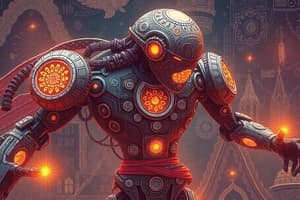Podcast
Questions and Answers
Match the following robotics aspects with their descriptions:
Match the following robotics aspects with their descriptions:
Mechanical Construction = Helps robots complete tasks in their environment Electrical Components = Control and power the machinery Software Program = Tells a robot when and how to carry out a task Autonomy Level = Refers to the ability of a robot to operate without human influence
Match the following robotics-related terms with their meanings:
Match the following robotics-related terms with their meanings:
Robotics = The field of study focused on developing robots and automation Robot = A programmable machine that can complete a task Robota = The Czech word that means forced labor R.U.R. = A 1920 play that introduced the term robot
Match the following robotics components with their functions:
Match the following robotics components with their functions:
Wheels = Help a robot firmly grip a terrain Battery = Powers a robot's machinery Computer Program = Tells a robot what to do Titanium Tubing = Makes up the mechanical construction of a robot
Match the following robotics applications with their industries:
Match the following robotics applications with their industries:
Match the following robotics characteristics with their descriptions:
Match the following robotics characteristics with their descriptions:
Match the following robot components with their functions:
Match the following robot components with their functions:
Match the following robot components with their characteristics:
Match the following robot components with their characteristics:
Match the following with the type of robot that uses it:
Match the following with the type of robot that uses it:
Match the following sensors with their functions:
Match the following sensors with their functions:
Match the following with the type of actuator that uses it:
Match the following with the type of actuator that uses it:
Flashcards are hidden until you start studying
Study Notes
What Is Robotics?
- Robotics is the intersection of science, engineering, and technology that produces machines, called robots, that replicate or substitute for human actions.
- Robots perform basic and repetitive tasks with greater efficiency and accuracy than humans, making them ideal for industries like manufacturing.
What Is a Robot?
- A robot is a programmable machine that can complete a task.
- Robotics describes the field of study focused on developing robots and automation.
- Each robot has a different level of autonomy, ranging from human-controlled bots to fully-autonomous bots.
Etymology of the Word "Robot"
- The word 'robot' is derived from the Czech word robota, which means “forced labor.”
- The word first appeared in the 1920 play R.U.R., in reference to the play’s characters who were mass-produced workers incapable of creative thinking.
Robotics Aspects
Mechanical Construction
- The mechanical aspect of a robot helps it complete tasks in the environment for which it’s designed.
- Example: Mars 2020 Rover’s wheels are individually motorized and made of titanium tubing that help it firmly grip the harsh terrain of the red planet.
Electrical Components
- Robots need electrical components that control and power the machinery.
- Electric current (e.g., a battery) is needed to power a large majority of robots.
Software Program
- Robots contain at least some level of computer programming.
- Without a set of code, a robot would just be another piece of simple machinery.
Main Components of a Robot
Control System
- Computation includes all of the components that make up a robot’s central processing unit, often referred to as its control system.
- Control systems are programmed to tell a robot how to utilize its specific components.
Sensors
- Sensors provide a robot with stimuli in the form of electrical signals that are processed by the controller.
- Examples of sensors: video cameras (function as eyes), photoresistors (react to light), and microphones (operate like ears).
Actuators
- Actuators are the components responsible for a robot's movement.
- Examples of actuators: motors that receive signals from the control system and move in tandem to carry out the movement necessary to complete the assigned task.
Power Supply
- Robots require power to function, similar to the human body requiring food.
- Power sources: AC power (stationary robots), internal battery (most robots), lead-acid batteries (safe, long shelf life), and silver-cadmium batteries (compact, expensive).
Studying That Suits You
Use AI to generate personalized quizzes and flashcards to suit your learning preferences.




